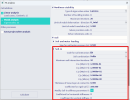Required parameters for Soil-in calculation
What all must be defined:
- Project with at least one borehole with predefined geologic profile
- Structure with surface support type Soilin or Both
- Load
- Combination type Linear (ULS or SLS)
Soil-in settings in the Solver setup
linear combination which is used for the soil-in calculation.
Even though it is not an exact solution, for practical reasons the C parameters are not calculated separately for each load case or each load case combination. The user must specify one particular reference combination that is used to calculate the C parameters. The calculated C parameters are then applied in all remaining defined load cases and combinations.
Maximum soil interaction iteraction
number of iteration cycles (when the program stops iterations if there are still no proper C parameter calculated, in case that results diverge), the max. limit is 99 steps
C1x:
the parameter defined by the user
C1y:
the parameter defined by the user
C1z:
initial value for soil-in (if the support type is Soilin)
C2x:
initial value for soil-in (if the support type is Soilin)
C2y:
initial value for soil-in (if the support type is Soilin)
Thickness of loose layer at contact level [m]:
setting in solver settings for automatic definition of loose layer at contact stress level for better handling of foundation at great depth and faster convergence of soilin iterations. This layer is automatically created and managed by soilin to handle the fact, that a thin layer of soil is always somewhat damaged and loose, just at the contact level. This item is set 0 as default. User can choose this layer 0 - 10m.
On the background new layer in borehole under the slab is created with thickness from this parameter and other parameters according layer in this possition from borehole but parameter 'm' is set as 0.
Coefficient for rigid soil [-]
This coefficient is used for multiplying the starting stiffness to be used for modeling a rigid support.
In case that in some part the result of the settlement is 0, the stiffness in that point should be theoretically infinite. That is numerically problematic, therefore the value of the starting stiffness multiplied by this coefficient is used in this case.
For example, if the starting stiffness is C1z = 10 MN/m3 and the coefficient for rigid soil is 100 then the "infinite" stiffness is considered C1z = 1000 MN/m3.
Sometimes, the big differences between stiffness values during iterations can lead to "oscillation" of iterations. In such cases, it is recommended to reduce the coefficient for rigid soil for example to 10. It means that the "infinite" stiffness would be lower but still reasonable. Due to smaller differences in stiffnesses the whole iteration process can be stabilized.
Modify Soilin stiffness parameters for seismic analysis: "Modify Soilin stiffness parameters for seismic analysis"
parameters of soil-in in seismic spectral analysis are modified for modal analysis by coef.
Coefficient for horizontal stiffnesses:
coefficient for horizontal components of stiffness support
Coefficient for vertical stiffness:
coefficient for vertical components of stiffness support
The source of not calculated parameters depends on the support type. It is described in the previous chapter.

